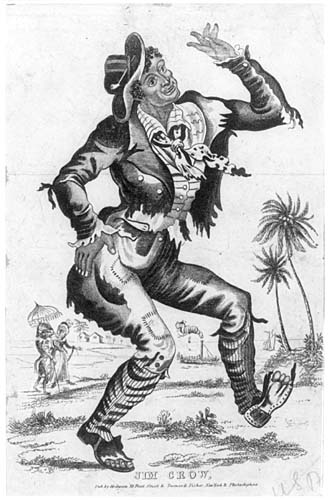Troupe(s): Soloist
Role: actor, dancer, singer, playwright.
Info: Thomas Dartmouth Rice was born in the Seventh Ward in New York to a poor family. Although his parentage is not clear, it is likely that he was the son of ship’s rigger John Rice. After he attended school, T. D. Rice began an apprenticeship as a ship’s carver. He switched to apprenticing in small theatres, including one on Cherry Street. By August 1828, he was performing as a stock actor at the Lafayette Theatre in New York. The same year, Rice moved to Noah Ludlow’s company, which was based in the Chatham Theatre. Rice worked there as “a fill-in actor and assistant to the property man”, but entered the acting company when the troupe toured to Mobile and one of the actors did not work out. Rice took over, playing the role of Wormwood in The Lottery Ticket. Rice left this company in 1829, though, linking up with the veteran actor Mrs. Hartwig in Pensacola to perform at the Tivoli Hotel. Here, Rice performed in A Day after the Fair, The Irish Tutor, and The Cobbler’s Daughter. By this time, he had also been performing prototypes of Jim Crow.
In 1830, Rice switched from prototypes to full blackface performances, the first being in Pittsburgh or in Ludlow’s Amphitheatre, Louisville. Two years later, at the age of 24, Rice toured his Jim Crow act across the northeastern seaboard. Jim Crow was a role that Rice both created and popularized. There are many legends about how it began, including that Rice learned the dance by observing dances performed by blacks. Certainly, the Jim Crow act began with a song and dance and expanded from there. By 1833, at the latest, Rice was performing his act at the Bowery. During the early 1830s, Rice also performed in his show Bone Squash Diavolo. In 1836, Rice took his Jim Crow act to the Surrey Theatre in London. On June 18, of the following year, he married Miss Gladstone, who was one of the daughters of the manager of the Surrey Theatre. Rice returned to the United States that same year, but frequently went back to England. He remained popular in England and the United States, playing in many different theatres. He also wrote a number of songs and burlesques, many of which were based on English models. Two of Rice’s popular burlesques were The Virginian Mummy and Bone Squash. Rice often would perform the role of Ginger Blue from The Virginian Mummy over the course of his career.
Around 1840, Rice was struck by an attack of paralysis which left him without the ability to speak or use his limbs for a time. This forced him to cancel performances until he recovered. He did return to the stage, however, both continuing his act and playing in Otello, a blackface burlesque based on Shakespeare’s Othello and Maurice Dowling’s burlesque. Near the end of his career, Rice was playing Uncle Tom in versions of Uncle Tom’s Cabin, including H. E. Stevens’ version which was performed at the Bowery Theatre. Even after his performance career was finished, Rice’s influence and scripts continued to inspire other minstrels. His work began losing popularity around the mid-1850s, but Charley White bought up some of the rights or at least some of the scripts.
Rice died in 1860 at the age of 53, but he remains famous for his work. During his lifetime, Rice was considered to be a talented mimic and a famous jig dancer. In fact, he was so popular, that for a time, on two continents, he was considered to be the highest paid actor.
Please see the 'Bibliographic Sources' link at right for a complete listing of materials (both primary and secondary) from which the above information was compiled.
Danielle Szlawieniec-Haw, Carolyn Farrell, and Keren Zaiontz
Edited by Alexis Butler

 On the Road Again
On the Road Again
